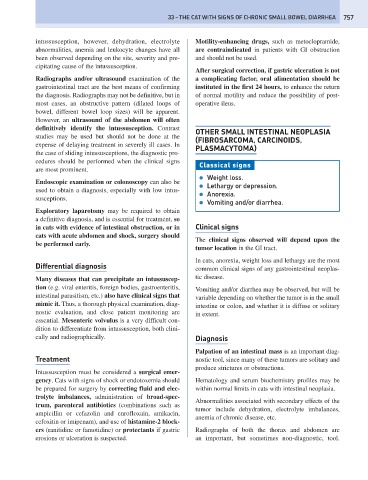Page 765 - Problem-Based Feline Medicine
P. 765
33 – THE CAT WITH SIGNS OF CHRONIC SMALL BOWEL DIARRHEA 757
intussusception, however, dehydration, electrolyte Motility-enhancing drugs, such as metoclopramide,
abnormalities, anemia and leukocyte changes have all are contraindicated in patients with GI obstruction
been observed depending on the site, severity and pre- and should not be used.
cipitating cause of the intussusception.
After surgical correction, if gastric ulceration is not
Radiographs and/or ultrasound examination of the a complicating factor, oral alimentation should be
gastrointestinal tract are the best means of confirming instituted in the first 24 hours, to enhance the return
the diagnosis. Radiographs may not be definitive, but in of normal motility and reduce the possibility of post-
most cases, an obstructive pattern (dilated loops of operative ileus.
bowel, different bowel loop sizes) will be apparent.
However, an ultrasound of the abdomen will often
definitively identify the intussusception. Contrast
OTHER SMALL INTESTINAL NEOPLASIA
studies may be used but should not be done at the
(FIBROSARCOMA, CARCINOIDS,
expense of delaying treatment in severely ill cases. In
PLASMACYTOMA)
the case of sliding intussusceptions, the diagnostic pro-
cedures should be performed when the clinical signs
Classical signs
are most prominent.
● Weight loss.
Endoscopic examination or colonoscopy can also be
● Lethargy or depression.
used to obtain a diagnosis, especially with low intus-
● Anorexia.
susceptions.
● Vomiting and/or diarrhea.
Exploratory laparotomy may be required to obtain
a definitive diagnosis, and is essential for treatment, so
in cats with evidence of intestinal obstruction, or in Clinical signs
cats with acute abdomen and shock, surgery should
The clinical signs observed will depend upon the
be performed early.
tumor location in the GI tract.
In cats, anorexia, weight loss and lethargy are the most
Differential diagnosis common clinical signs of any gastrointestinal neoplas-
Many diseases that can precipitate an intussuscep- tic disease.
tion (e.g. viral enteritis, foreign bodies, gastroenteritis, Vomiting and/or diarrhea may be observed, but will be
intestinal parasitism, etc.) also have clinical signs that variable depending on whether the tumor is in the small
mimic it. Thus, a thorough physical examination, diag- intestine or colon, and whether it is diffuse or solitary
nostic evaluation, and close patient monitoring are in extent.
essential. Mesenteric volvulus is a very difficult con-
dition to differentiate from intussusception, both clini-
cally and radiographically. Diagnosis
Palpation of an intestinal mass is an important diag-
Treatment nostic tool, since many of these tumors are solitary and
produce strictures or obstructions.
Intussusception must be considered a surgical emer-
gency. Cats with signs of shock or endotoxemia should Hematology and serum biochemistry profiles may be
be prepared for surgery by correcting fluid and elec- within normal limits in cats with intestinal neoplasia.
trolyte imbalances, administration of broad-spec-
Abnormalities associated with secondary effects of the
trum, parenteral antibiotics (combinations such as
tumor include dehydration, electrolyte imbalances,
ampicillin or cefazolin and enrofloxain, amikacin,
anemia of chronic disease, etc.
cefoxitin or imipenam), and use of histamine-2 block-
ers (ranitidine or famotidine) or protectants if gastric Radiographs of both the thorax and abdomen are
erosions or ulceration is suspected. an important, but sometimes non-diagnostic, tool.

